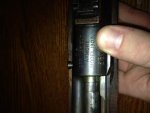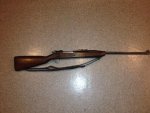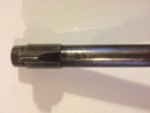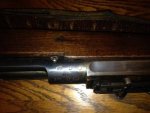Hey everyone I am new to this site and this is my very first post. I went to a gun show yesterday and picked up a 1903 springfield that has been somewhat sporterized and the stock cut down. It's a little rough but I thought for $225 it wasn't a bad deal and I'd hate to see a gun like that go to waste. It appears to be a low serial numbers 1913 with original barrel I believe. It also has two drilled and tapped holes in the left side of the reciever so I am weary about shooting it and am open to suggestions for restoring it and what I should do to it. Thank you!
- Thread starter Gunnut92
- Start date
You are using an out of date browser. It may not display this or other websites correctly.
You should upgrade or use an alternative browser.
You should upgrade or use an alternative browser.
Do some web research on the serial number of the action, very early production has questionable safety to shoot if it is in the ranges that were affected by the heat treatment process. Also pay attention if it was a springfield or rock island rifle. If the receiver is good, then you can go from there on restoration or making a shooter. If it has been drilled and tapped, it will make a better shooter than collector. Hope you got a good one.
Do some web research on the serial number of the action, very early production has questionable safety to shoot if it is in the ranges that were affected by the heat treatment process. Also pay attention if it was a springfield or rock island rifle. If the receiver is good, then you can go from there on restoration or making a shooter. If it has been drilled and tapped, it will make a better shooter than collector. Hope you got a good one.
The serial number is 537xxx it is a springfield. It is in the unsafe zone of serial numbers to shoot. I've seen Winchester makes a 30.06 round specifically for springield a but I am unsure whether or not that makes it a low powder round or not. I will try to post pictures later on today.
I love Springfield's. At that price I would have bought it (a guess without seeing the pictures), but I wouldn't shoot it. People shoot low numbered rifles all time, but people drive without seat belts all the time too, doesn't make it safe.
When you work with metal, you have to determine how hard or elastic you want it. You heat the metal to its critical temp., then quench it (normally in oil, sometimes water). Depending on the carbon content this makes the metal hard yet brittle. Depending on what you want to do with that metal, you decide how you want to draw the temper out, making it hard but somewhat elastic, so it gives without shattering.
Look at it as a plate glass window. Glass is hard but brittle. You can toss a marble at it and it may or may not break. You may toss several marbles and it wont break, of the first marble may break it. The thing is, you never know which marble, if any, will break the glass. The same is true for the early Springfield/Rock Island 1903s.
As a CMP GSM MI, I would follow the CMP rules and not let anyone shoot a low numbered rifle in any of the matches I put on.
But I would buy one. I'd would restore it the best I can, add a bayonet and use it as a wall display.
I don't know about the Winchester ammo you are talking about but I doubt any manufacture is going to make ammo advertised for a low numbered Springfield or Rock Island. Their lawyers would throw a fit.
I don't understand why anyone would make special ammo for the high number or double heat treated Springfields. They don't need it, they can take the pressure of any normal '06 ammo.
"Special" (for lack of a better term), is made by several companies for the Garand, not that the Garand cant take the pressure, but its where the pressure is applied that affects the Garand. The gas system of the Garand is designed for medium powder (4895-4064, etc) and bullet weights of < 180 gr. In fact 4895 was designed for the Garand.
But that's do to the gas system that the Springfields/M1917s don't have so that would come into play. The can take ammo with slow powders and heavier bullets without problems.
When you work with metal, you have to determine how hard or elastic you want it. You heat the metal to its critical temp., then quench it (normally in oil, sometimes water). Depending on the carbon content this makes the metal hard yet brittle. Depending on what you want to do with that metal, you decide how you want to draw the temper out, making it hard but somewhat elastic, so it gives without shattering.
Look at it as a plate glass window. Glass is hard but brittle. You can toss a marble at it and it may or may not break. You may toss several marbles and it wont break, of the first marble may break it. The thing is, you never know which marble, if any, will break the glass. The same is true for the early Springfield/Rock Island 1903s.
As a CMP GSM MI, I would follow the CMP rules and not let anyone shoot a low numbered rifle in any of the matches I put on.
But I would buy one. I'd would restore it the best I can, add a bayonet and use it as a wall display.
I don't know about the Winchester ammo you are talking about but I doubt any manufacture is going to make ammo advertised for a low numbered Springfield or Rock Island. Their lawyers would throw a fit.
I don't understand why anyone would make special ammo for the high number or double heat treated Springfields. They don't need it, they can take the pressure of any normal '06 ammo.
"Special" (for lack of a better term), is made by several companies for the Garand, not that the Garand cant take the pressure, but its where the pressure is applied that affects the Garand. The gas system of the Garand is designed for medium powder (4895-4064, etc) and bullet weights of < 180 gr. In fact 4895 was designed for the Garand.
But that's do to the gas system that the Springfields/M1917s don't have so that would come into play. The can take ammo with slow powders and heavier bullets without problems.
That barrel is in the expected date range for that serial number.
The problem with "low number" M1903 rifles started with the forging operation of the receiver billets. The workers in the forge shops in Springfield and Rock Island (who were trained at SA) were eyeballing the color of the receiver billets to determine the correct temperature. An unknown number of receiver billets were overheated and burned. They were subsequently machined into receivers and assembled into rifles. Heat treatment at SA and RIA was always controlled with pyrometers, insuring the proper temperatures were reached.
As long as the cartridges used in them fired correctly, the rifles performed as expected. The problem is that the receivers manufactured from the burned billets were brittle and would shatter when they failed...a case head failure would result in a catastrophic failure of a burned receiver. Add to the mix poor WW1 era ammunition and rifles started failing in the field. Also, the M1903 has relatively poor gas escape provisions, especially when compared to the Mauser 98. There is no way too tell through non destructive inspection methods whether a low number receiver is brittle or not... you need to conduct a costs/benefit analysis as to whether or not to shoot it. There are plenty of double heat treated and nickel steel M1903s on the market if you really want a shooter M1903.
The proper stock, hand guard and upper band in nice condition and original finish won't be cheap, and you will pay more for them than the rifle will be worth. The holes for the receiver sight (was probably a Lyman 48) pretty much killed any monetary value as a restored rifle...would make a nice display piece.
The problem with "low number" M1903 rifles started with the forging operation of the receiver billets. The workers in the forge shops in Springfield and Rock Island (who were trained at SA) were eyeballing the color of the receiver billets to determine the correct temperature. An unknown number of receiver billets were overheated and burned. They were subsequently machined into receivers and assembled into rifles. Heat treatment at SA and RIA was always controlled with pyrometers, insuring the proper temperatures were reached.
As long as the cartridges used in them fired correctly, the rifles performed as expected. The problem is that the receivers manufactured from the burned billets were brittle and would shatter when they failed...a case head failure would result in a catastrophic failure of a burned receiver. Add to the mix poor WW1 era ammunition and rifles started failing in the field. Also, the M1903 has relatively poor gas escape provisions, especially when compared to the Mauser 98. There is no way too tell through non destructive inspection methods whether a low number receiver is brittle or not... you need to conduct a costs/benefit analysis as to whether or not to shoot it. There are plenty of double heat treated and nickel steel M1903s on the market if you really want a shooter M1903.
The proper stock, hand guard and upper band in nice condition and original finish won't be cheap, and you will pay more for them than the rifle will be worth. The holes for the receiver sight (was probably a Lyman 48) pretty much killed any monetary value as a restored rifle...would make a nice display piece.
Hmm is there anyway of finding the forgers proof marks? Would that help any? I'm not sure what to do with it I've recently just started collecting this past year and I really enjoy it and have learned so much. I recently bought a mauser model 98 that someone has sporterized and a British lee enfield mark 1/2 that someone sporterized and cut the sights off of. I see potential in guns when I see them like that and I can't help it I just have to buy them haha. I plan on building shooters out of them because it would just cost too much to restore them.
You will hear a lot from people saying the low number rifles are unsafe, but in reality how many of those low number rifles blew up in battle because of to much pressure? I personally would not have a second thought about shooting a low number rifle, but with that being said I have a special hand load for those particular older rifles. This is just what I do, and I am not advising you to take any particular action other than making sure what ever you do is safe, and that may include having the rifle checked out by a professional before shooting it and maybe coming up with your own reduced load for it.
As for this statement:
As for this statement:
I do agree to an extent with the statement, but going along with what I have previously stated, there is a difference between driving 10mph in a field with no seat belt on and driving 100mph on an icy road in heavy traffic with no seatbelt, neither may be really safe, but you can take actions and make decisions to mitigate the dangers.People shoot low numbered rifles all time, but people drive without seat belts all the time too, doesn't make it safe.
There are no specific forge marks allowing anyone to determine whether the receiver was manufactured from a burned billet. If there was a way, the Ordnance Department would have found it. Hatcher's Notebook by Maj. Gen Julian S. Hatcher will give you all the gory details... Hatcher was intimately involved in the investigation into low number M1903 failures.
Remember, each of these rifles passed proof fire and subsequent service use with service ammunition. As long as the cartridge case is intact, nothing untoward will occur. A failed cartridge will dump gasses into the coned area of the breech and receiver ring, spiking pressure in an area outside the pressure containment area (chamber). There is a relatively low reserve of strength in a low number receiver, and no reserve of strength in one made from a burned billet. Handloading to a lower velocity load probably won't appreciably lower operating pressure to a "safe" level (a safe bet cartridge would be .22LR, Numrich made a conversion kit that worked well)... and I don't have access to a pressure test rifle to check.
Most injuries from burst M1903 rifles were to the eyes of the shooter... high quality eye protection wasn't in vogue until relatively recently. As long as the case holds, you will probably not have an issue.
When you said there were holes drilled I assumed it was for a receiver sight.... looking at your photo I can see that they were made for some form of tip off scope base on the receiver... Weaver I bet.
Remember, each of these rifles passed proof fire and subsequent service use with service ammunition. As long as the cartridge case is intact, nothing untoward will occur. A failed cartridge will dump gasses into the coned area of the breech and receiver ring, spiking pressure in an area outside the pressure containment area (chamber). There is a relatively low reserve of strength in a low number receiver, and no reserve of strength in one made from a burned billet. Handloading to a lower velocity load probably won't appreciably lower operating pressure to a "safe" level (a safe bet cartridge would be .22LR, Numrich made a conversion kit that worked well)... and I don't have access to a pressure test rifle to check.
Most injuries from burst M1903 rifles were to the eyes of the shooter... high quality eye protection wasn't in vogue until relatively recently. As long as the case holds, you will probably not have an issue.
When you said there were holes drilled I assumed it was for a receiver sight.... looking at your photo I can see that they were made for some form of tip off scope base on the receiver... Weaver I bet.
Last edited:
Similar threads
- Replies
- 11
- Views
- 352
- Replies
- 0
- Views
- 330
- Replies
- 19
- Views
- 2K





